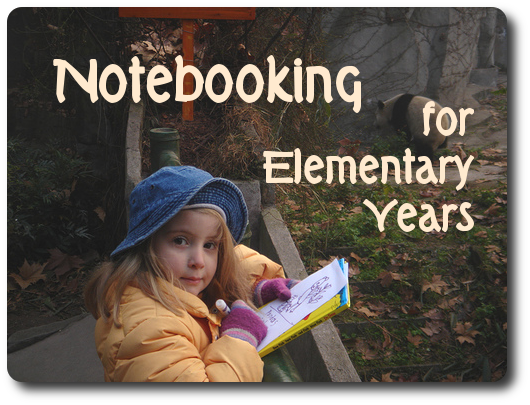- in How-tos , Tips by Jimmie Quick
Notebooking With Little Kids
When I shared a guest post over at Mary’s blog about Getting Started with Notebooking, Corrie asked a great question:
Could you go into more detail about notebooking with little kids?
Sure! Let’s talk about notebooking for the elementary age.
In the photo above, Emma was 6 years old and in 2nd grade. Taking notes at the panda reserve was her own idea. You can see she has drawn the animals and written a single word label “panda.”
My Philosophy
First of all, I am not a proponent of formal school for preschool or even kindergarten. I think those years should be filled with trips to the zoo, backyard exploration, crafts, and lots of reading outloud (to them, of course).
I also find that lapbooking is a good fit for concrete learners for ages 5-9. The physical construction of the books help children understand how to divide and organize information into logical chunks. This simple skill is an important foundation of expository writing that will come in middle school and high school.
So although you can use notebooking with non-readers and non-writers, I want to be clear that I do not encourage it at the expense of other more concrete and hands-on techniques.
Notebooking for Pre-Readers and Pre-Writers
If you occasionally want to incorporate notebooking with a child who does not yet read or write independently, there are several modifications you can make.
Serve as scribe
You can write what your child says. This is not cheating. Composing is a mental process and should never be confused with handwriting which is a physical one.
Rely on images
Your child can express himself through images. He can draw them or can cut and order images that you provide.
Notebooking for Early Readers and Writers
Once children begin to read and write, you can help them make more traditional notebooking pages. This would begin as early as 1st grade for some children. But these methods can continue to be used into 4th grade.
Serve as scribe — sometimes
Yes, you may want to continue as a scribe for some subjects, especially if the writing load has been heavy for other academic areas.
Allow the child to copy what he dictated
This is the transition step from mom’s serving as scribe to the child writing on his own. Talk over the narration, helping your child to put his ideas into words. Write down what he says, using correct punctuation and spelling.
Then have your child simply copy what he composed with your help. With the composing step out of the way, he can focus on handwriting, capitalization, and punctuation.
For a first grader, a notebooking page may have only one complete sentence and a large image. Gradually increase this length until a child in 4th grade is writing (or copying) an entire paragraph.
My biggest warning here is to not rush the transition. Your children will naturally mature into writing more and more. You do not have to push this process. In fact, pushing is normally counterproductive.
You have many years to reach the final goal of independent notebooking with multiple paragraphs (essays) in high school. Enjoy the fun of cut and paste and stick figure drawings in these early years. They pass quickly.
If you want more about notebooking at different ages, visit Carlie’s blog where I have a guest post about notebooking at all stages.


